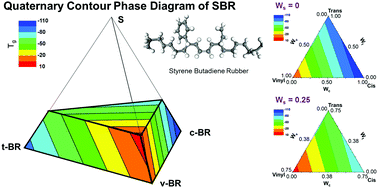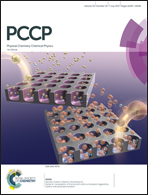Prediction of the glass transition temperature and design of phase diagrams of butadiene rubber and styrene–butadiene rubber via molecular dynamics simulations†
Abstract
To prevent car accidents, it is important to evaluate the thermal stability of tire rubbers, such as natural rubber (NR), butadiene rubber (BR), and styrene–butadiene rubber (SBR). Controlling the glass transition temperature (Tg) is the main factor for obtaining desirable thermal stability. Here, we developed an optimized equation for the prediction of the Tg of the various rubber systems using molecular dynamics (MD) simulations. We modeled a random copolymer system, blended monomers, and calculated the Tg of butadiene isomers in each composition. From these results, we designed the Tg contour of ternary cis–trans–vinyl butadiene and derived an equation of Tg for the ternary system. Moreover, we developed an equation to evaluate the pseudo-ternary Tg of quaternary SBR and plotted it. Our results present a novel way of predicting the Tg of ternary BR and quaternary SBR, which is critical for rational tire design with optimized thermal and mechanical stability.



 Please wait while we load your content...
Please wait while we load your content...